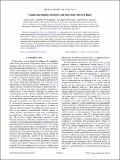Casimir microsphere diclusters and three-body effects in fluids
Author(s)
Varela, Jaime; Rodriguez, Alejandro W.; McCauley, Alexander Patrick; Johnson, Steven G.
DownloadVarela_Casimir microsphere.pdf (814.4Kb)
PUBLISHER_POLICY
Publisher Policy
Article is made available in accordance with the publisher's policy and may be subject to US copyright law. Please refer to the publisher's site for terms of use.
Alternative title
Casimir microsphere diclusters and three-body effects in fluids
Terms of use
Metadata
Show full item recordAbstract
Our previous paper [Phys. Rev. Lett. 104, 060401 (2010)] predicted that Casimir forces induced by the material-dispersion properties of certain dielectrics can give rise to stable configurations of objects. This phenomenon was illustrated via a dicluster configuration of nontouching objects consisting of two spheres immersed in a fluid and suspended against gravity above a plate. Here, we examine these predictions from the perspective of a practical experiment and consider the influence of nonadditive, three-body, and nonzero-temperature effects on the stability of the two spheres. We conclude that the presence of Brownian motion reduces the set of experimentally realizable silicon-teflon spherical diclusters to those consisting of layered microspheres, such as the hollow core (spherical shells) considered here.
Date issued
2011-04Department
Massachusetts Institute of Technology. Department of Mathematics; Massachusetts Institute of Technology. Department of PhysicsJournal
Physical Review A
Publisher
American Physical Society
Citation
Varela, Jaime et al. “Casimir Microsphere Diclusters and Three-body Effects in Fluids.” Physical Review A 83.4 (2011) : 042516. ©2011 American Physical Society.
Version: Final published version
ISSN
1050-2947
1094-1622